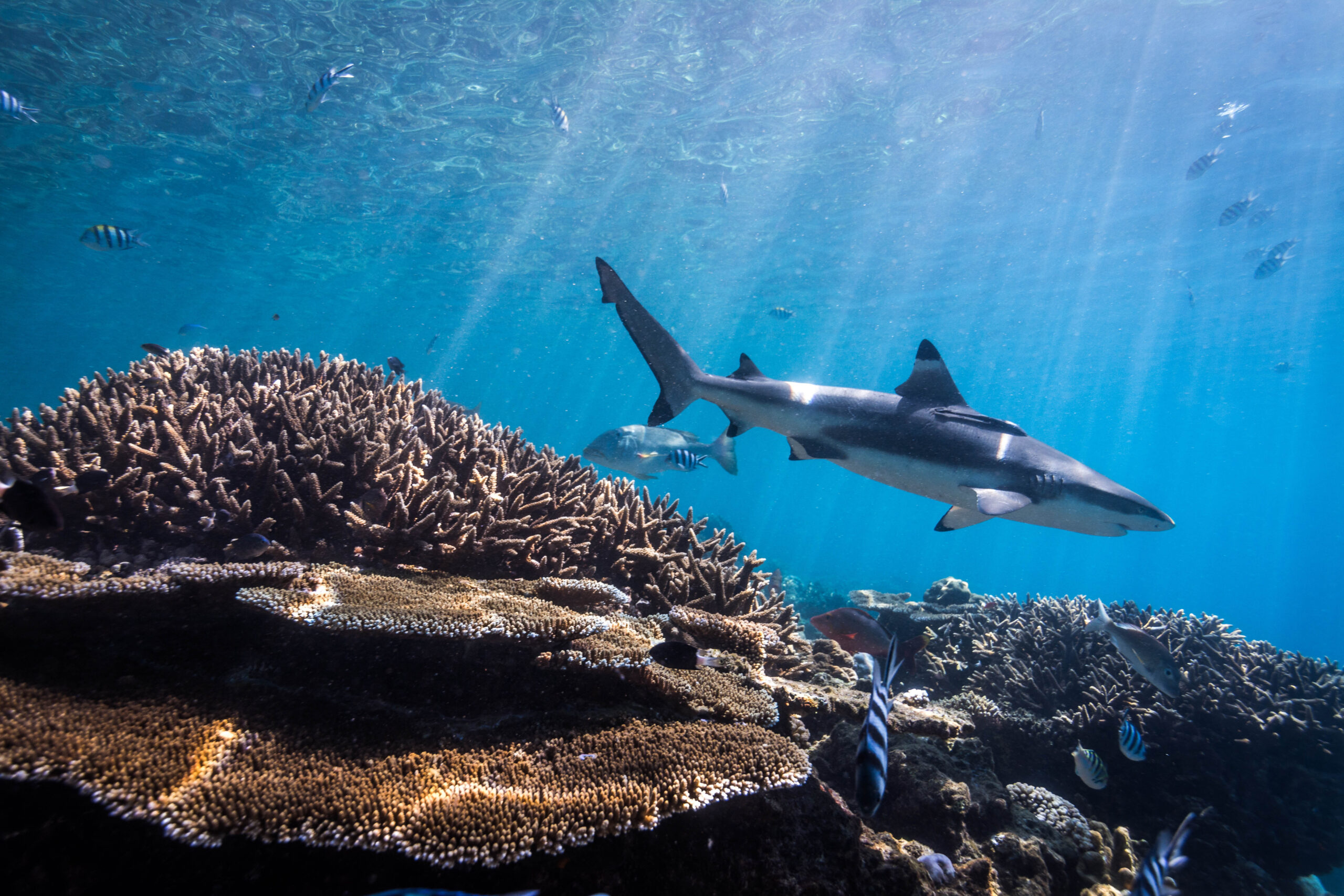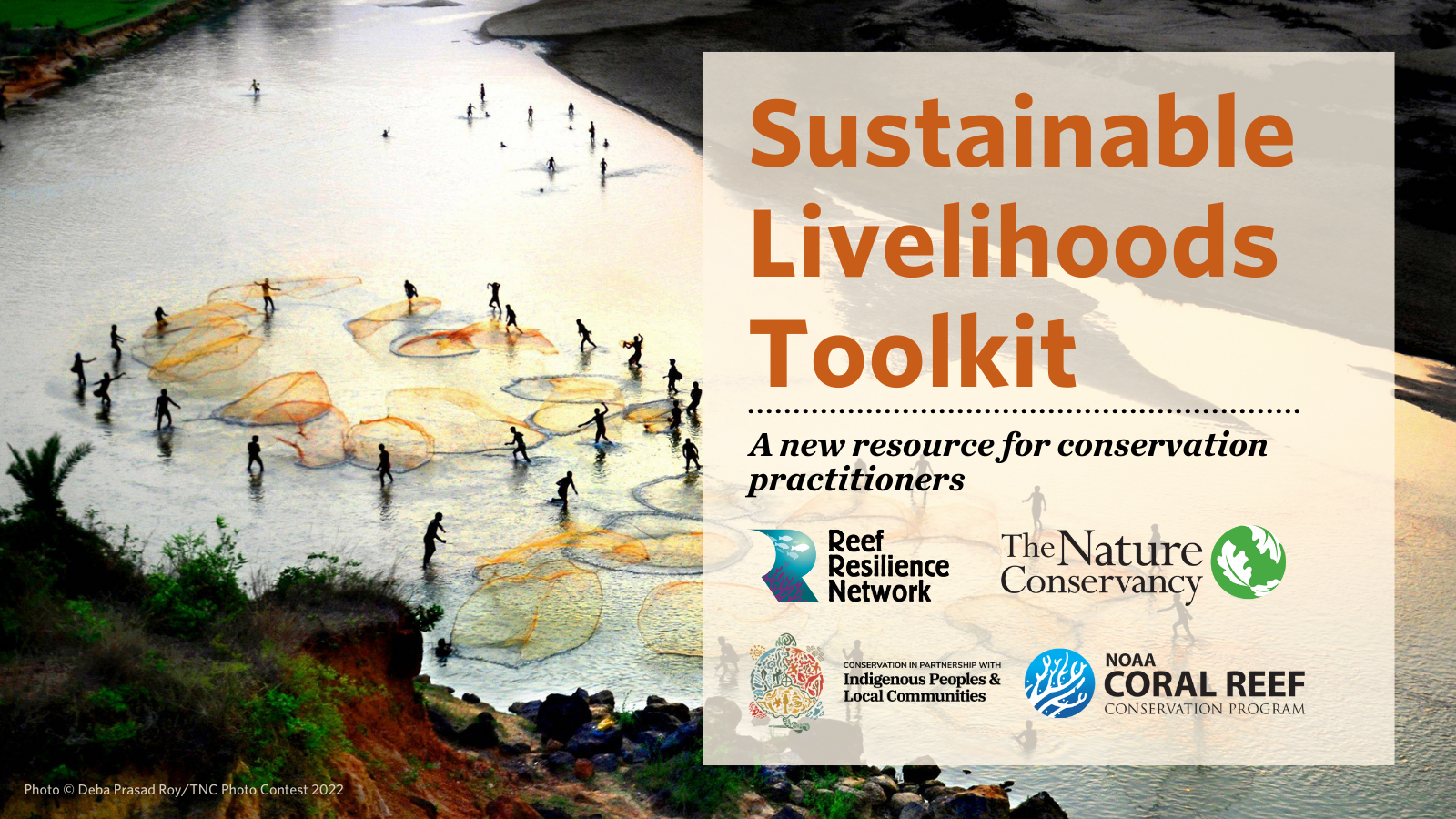Using Remote Sensing Technology to Inform Suitable Outplanting Sites in the Dominican Republic
Location
Southeast Marine Sanctuary, Dominican Republic
The challenge
Coral restoration efforts in the Dominican Republic are being led by local NGOs Fundación Grupo Puntacana (FGPC) and Fundación Dominicana de Estudios Marinos (FUNDEMAR), in close collaboration with TNC. As coral restoration practitioners, their programs focus on enhancing ecosystem services for the future, optimizing and scaling-up restoration, promoting coral reef conservation stewardship, and providing alternative, sustainable livelihood opportunities. Their overall goals are to reduce coral population decline and ecosystem degradation and to re-establish a self-sustaining, functioning reef ecosystem. Most of these objectives have been accomplished through asexual propagation of Acropora cervicornis, or the Caribbean staghorn coral.
FGPC and FUNDEMAR organize large outplanting events called “Coral Manias” in which stakeholders and volunteers, including local and international non-governmental organizations (NGOs), diving operators, the tourism sector, and the Dominican Government are engaged in three days of coral restoration efforts. An emerging need is the selection of the outplanting locations based on standardized criteria. In the past, selection criteria have relied on local expertise, which restricts the outplanting effort to small, well-known sections of reef. To build a cost-effective approach to outplanting site selection and to scale up restoration success, remote sensing techniques were tested as an alternative method to identify suitable sites for coral restoration.
Actions taken
In 2019, TNC and Arizona State University’s Center for Global Discovery and Conservation Science, in collaboration with FGPC, FUNDEMAR, and the Red Arrecifal Dominicana (RAD), flew the Global Airborne Observatory (GAO) over the southeastern reefs of the Dominican Republic, covering the Southeast Marine Sanctuary. The GAO uses an imaging spectrometer sensor that collects high-resolution, hyperspectral (427 samples of light per pixel) images of the seafloor. High-resolution maps were derived from these data representing bathymetry, percent live coral cover, habitat complexity (rugosity), and percent cover of algae, seagrass, and sand.
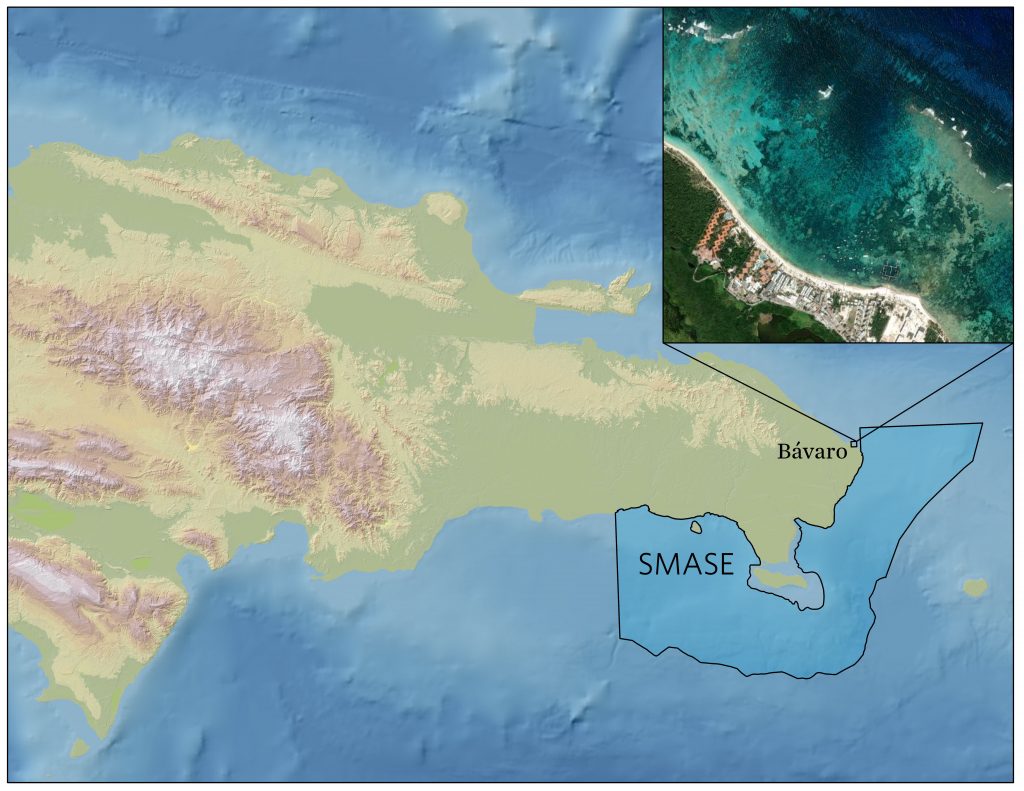
Location of sites, including the southeastern reefs of the Dominican Republic, covering the Southeast Marine Sanctuary (SMASE) and Bávaro. Photo © TNC
Outplanting sites were selected using logistical and ecological criteria applied to these data, in close consultation with local experts, to maximize efficiency and coral survival when outplanting corals. Two logistical criteria aimed at facilitating the outplanting process and reducing time and costs in the field included:
- Minimize distance between the nursery and the outplanting site
- Minimize wave exposure (protected back reef habitats were prioritized)
Criteria for an outplanting site included hard substrate and low macroalgal cover. Ecological criteria were considered to enhance the probability of survivorship of outplants:
- Depth of 3-7 meters
- Maximize percentage of live coral cover: >2% (highest in this area was 10%)
- Minimize percentage of algal cover (<80%)
- Maximize habitat complexity: >0.3
These ranges were based on local conditions in the Bávaro area (i.e., <30% algal cover or higher live coral cover would be more ideal conditions but was not possible within the area of interest). The GAO-derived data layers were filtered to these ranges and subsequently intersected to identify areas that met all criteria. Using GPS coordinates, divers verified conditions before outplanting.
The Coral Outplanting Siting Guide, a Google Earth Engine app, was subsequently developed to allow stakeholders in the region to replicate this process in the Dominican Republic and Saint Croix using these data layers. Each of the input layers can be visualized and filtered by criteria thresholds. In this way, users can screen out areas that don’t meet the criteria and select suitable outplanting sites.
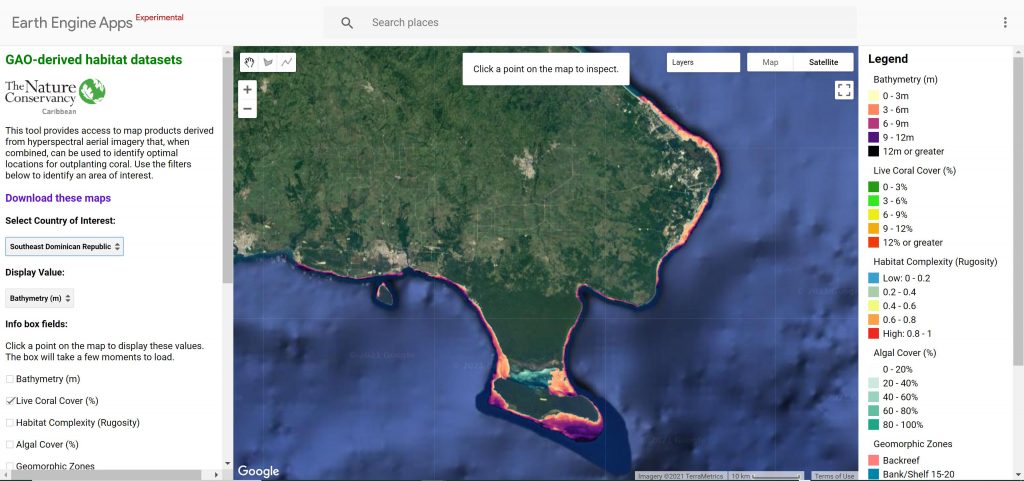
Coral Outplanting Siting Guide and web-based tool. Photo © TNC
How successful has it been?
The November 2019 Coral Mania event brought together dozens of volunteers, including NGOs, Dominican environmental authorities, dive operators, and other local stakeholders. A total of 1,722 Acropora cervicornis fragments were outplanted across sites in Bávaro (Cabeza de Toro).
In January and October 2020, TNC monitored the outplants in three randomly selected sites. In October 2020, almost a year after the outplant event, survivorship remained above 76%. The survey team did not find evidence of fragments detached from the substrate which further indicated the outplant suitability of the selected sites.
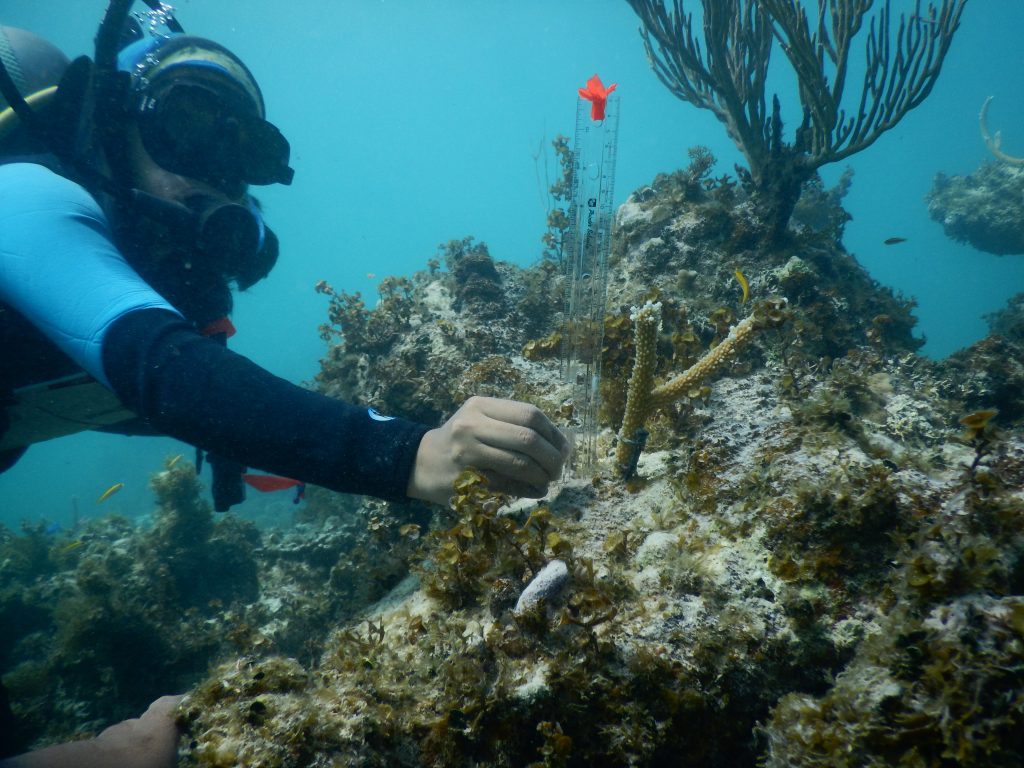
Monitoring the survivorship and growth of one of the coral outplants. Photo © TNC
Lessons learned and recommendations
- Derivatives from remote sensing data are a useful tool for efficiently identifying suitable sites for outplanting across a broad area
- GAO maps were accurate enough to select sites where conditions would likely increase coral outplant survivorship
- Long-term monitoring of these outplants is needed to better address and refine the criteria and restoration success
Funding summary
This research was funded by Daniel C. Chung, The Kowalski Family Foundation, The Tiffany & Co. Foundation (Grant No. 12171), The Paul G. Allen Family Foundation (Grant No. 12809), The Community Foundation of the Virgin Islands, The J.A. Woollam Foundation, and The John D. and Catherine T. MacArthur Foundation (Grant No. 96061-0). The Global Airborne Observatory is made possible by support provided by private foundations, visionary individuals, and Arizona State University.
Lead organizations
The Nature Conservancy, Caribbean Division
Arizona State University Center for Global Discovery and Conservation Science
Fundación Grupo Puntacana (FGPC)
Fundación Dominicana de Estudios Marinos (FUNDEMAR)
Red Arrecifal Dominicana (RAD)
Consorcio Domincano de Restauración in Costera
Resources
Remote Sensing and Mapping for Coral Reef Conservation
Publications
Schill, S.R., Asner, G.P., McNulty, V.P., Pollock, F.J., Croquer, A., Vaughn, N.R., Escovar-Fadul, X., Raber, G. and Shaver, E., 2021. Site selection for coral reef restoration using airborne imaging spectroscopy. Frontiers in Marine Science, p.1022. https://doi.org/10.3389/fmars.2021.698004
Authors
Aldo Croquer, Valerie McNulty, Steve Schill, Ximena Escovar-Fadul, F. Joseph Pollock

